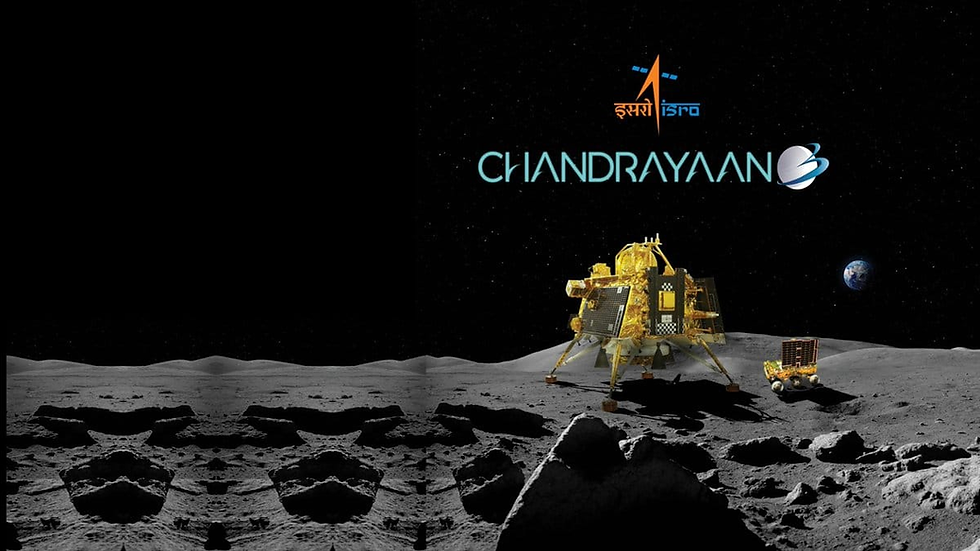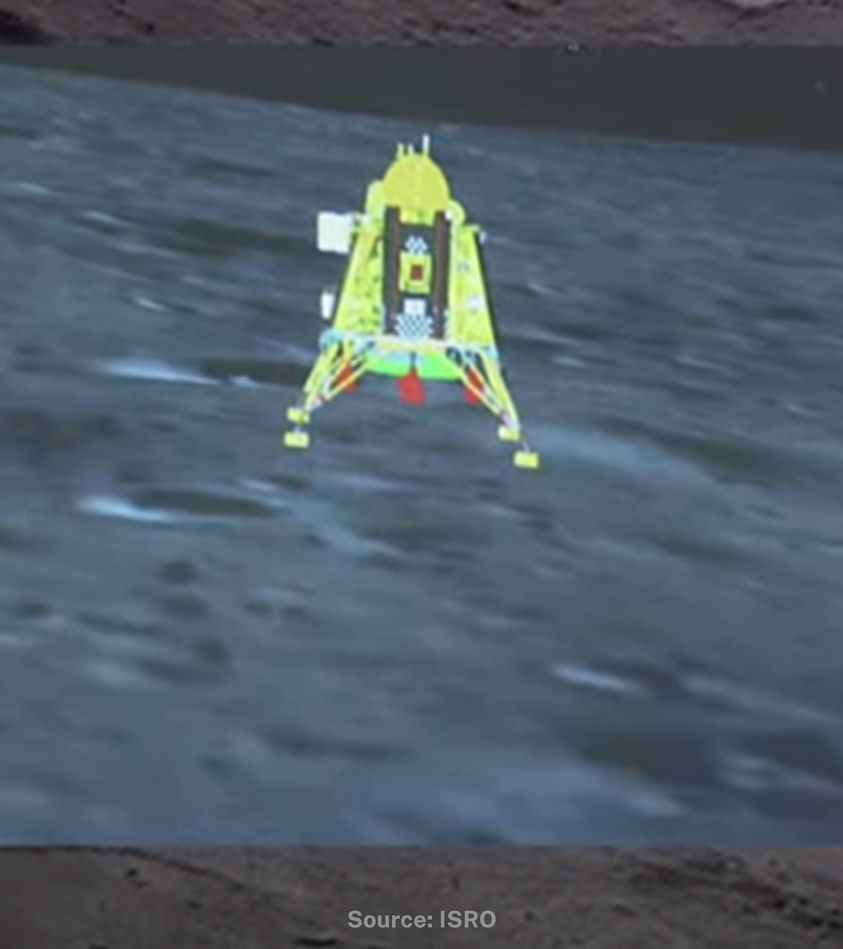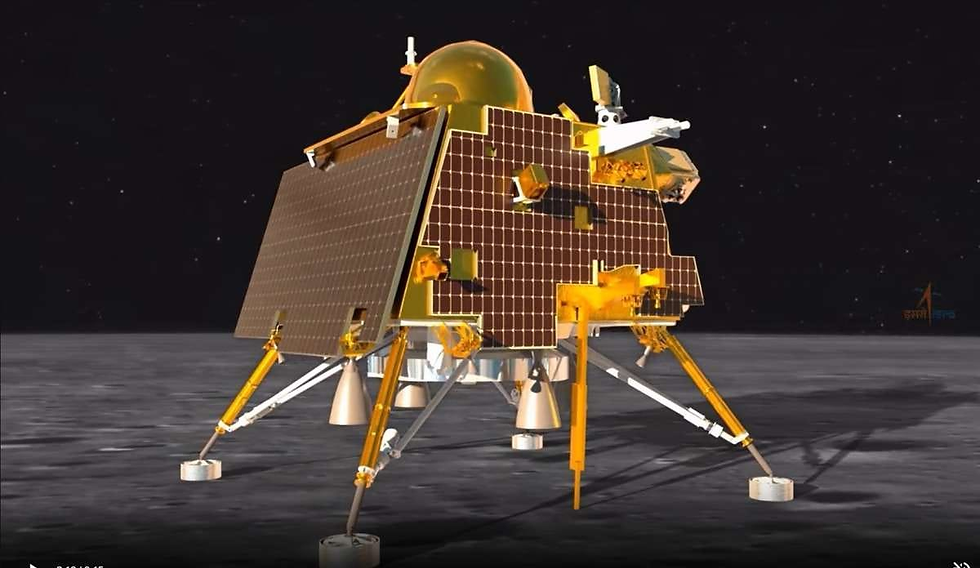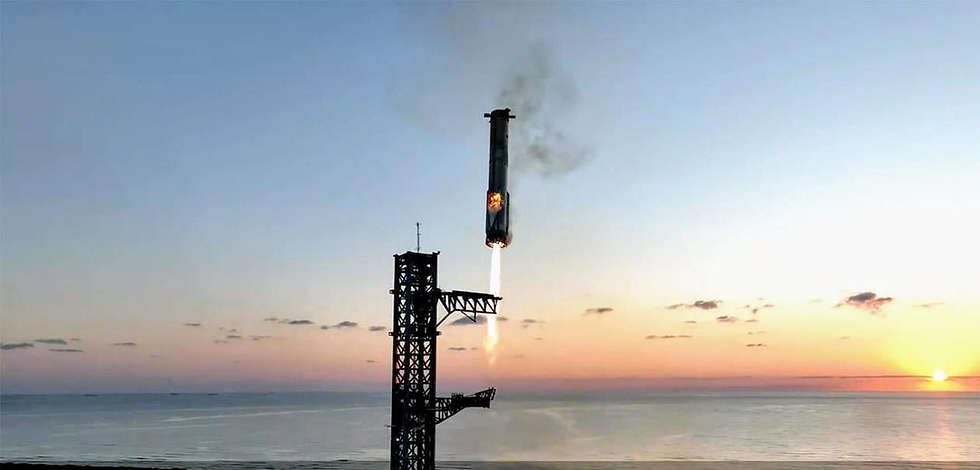!! Chandrayaan III - Exploring the Moon !!
- Shubhayan Mukherjee

- Oct 10, 2023
- 9 min read
Exciting news from the Indian Space Research Organisation (ISRO)! Chandrayaan III, the lunar exploration mission, launched on 14th July 2023 and landed on 23rd August 2023. This mission comprises a lander and rover configuration, aiming to uncover the secrets of our celestial neighbor. The lander and rover launched into a 100 km lunar orbit by the powerful LVM3 rocket from SDSC SHAR, Sriharikota. Accompanied by the propulsion module, the lander, and rover make their way to the lunar surface, equipped with cutting-edge scientific instruments for detailed investigations.

The rover carried a Laser Induced Breakdown Spectroscope (LIBS), utilizing laser pulses to analyze the chemical and mineralogical composition of the lunar surface. This incredible technology helped us understand the unique makeup of the Moon, from its elements to its geological history. It also included an Alpha Particle X-ray Spectrometer (APXS) to determine the elemental composition, specifically targeting elements such as magnesium, aluminum, silicon, potassium, calcium, titanium, and iron. These instruments provided valuable insights into the geological makeup of the Moon and helped scientists understand its composition.
Meanwhile, the lander boasted four fascinating payloads. The Radio Anatomy of Moon Bound Hypersensitive Ionosphere and Atmosphere (RAMBHA) payload monitored the dynamic changes in the lunar atmosphere, providing valuable insights into its behavior and interactions with space.
Chandra's Surface Thermophysical Experiment (ChaSTE) payload focused on studying the thermal properties of the lunar surface, enabling us to better comprehend temperature variations and heat flow.
The Instrument for Lunar Seismic Activity (ILSA) detected and measured moonquakes, unraveling the mysteries of the Moon's interior structure and composition. This data allowed us to gain insights into the geological processes that shaped our lunar companion.
Lastly, the Laser Retroreflector Array (LRA) provided by NASA enabled precise distance measurements between Earth and the Moon through laser signals. This payload continued the incredible legacy of laser-ranging experiments initiated during the Apollo missions, advancing our astronomical research.
With this mission, scientists aimed to conduct comprehensive investigations, unlocking the secrets of the Moon's composition, environment, and geological activity.

Let's explore the fascinating world of scientific discovery that lies ahead!
Decoding Lunar Composition with APXS
Alpha Particle X-ray Spectrometry (APXS) was a brilliant scientific technique that allowed us to analyze the elements within materials, especially on celestial bodies like Mars and the Moon. The process involved bombarding a sample with alpha particles (helium nuclei), which triggered the emission of X-rays. These X-rays provided valuable insights into the elements present in the material.
APXS had played a crucial role in missions like Curiosity and Perseverance on Mars, revealing the composition of rocks, soil, and dust, leading to significant discoveries about the planet's history and geology.
Powered by a 244 Cm radioactive source, APXS employed X-ray fluorescence spectroscopy to uncover lunar elements. Through the emission of alpha particles (5.8 MeV) and X-rays (14.3 & 18.3 keV), X-ray fluorescence was triggered and detected by a Silicon Drift Detector (SDD). With impressive efficiency and resolution (1-25 keV), APXS unveiled major elements (Na, Mg, Al, Si, Ca, Ti, Fe) and trace elements (Sr, Y, Zr) in the regolith. Operating at -35°C, APXS was set to uncover lunar mysteries. Notably, the detector was a compact 30 mm² with a thickness of 450 microns.
The mission of Chandrayaan III at the lunar south pole was awe-inspiring. This region was of immense interest due to its perpetually shadowed craters, believed to harbor water ice. This discovery could reshape our understanding of potential human exploration and the establishment of lunar habitats.
Enter APXS! This remarkable tool was tailor-made for the mission's objectives. It excelled at confirming the presence of water ice in these mysterious shadowy areas. By analyzing the elemental composition of the lunar surface, APXS could detect the unique signatures of hydrogen and oxygen, the building blocks of water. Furthermore, APXS could create detailed maps of water ice distribution across the lunar south pole. This information equipped future missions to target ice-rich areas accurately—a valuable resource for future lunar endeavors.
But APXS's capabilities didn't stop at ice detection. It was a key that unlocked insights into the composition of lunar regolith, revealing the Moon's geological history, interactions with solar wind, and the processes shaping its surface over eons. The data about elemental composition also offered clues about potential resources hidden within the lunar soil, from water ice to valuable metals. APXS held the key to what the Moon had in store for humanity's lunar aspirations.
In conclusion, grasping the significance of the lunar south pole mission and appreciating the role of APXS was essential in understanding the far-reaching implications of exploring this captivating lunar region.

Laser-Induced Breakdown Spectroscopy (LIBS)
LIBS, or Laser-Induced Breakdown Spectroscopy, serves as a cosmic detective tool, delving into the composition of materials through the generation of plasma via high-energy laser pulses. This resulting plasma emits light, unveiling the elemental makeup of the material.
A laser pulse, brimming with energy, homes in on the surface of a material. The laser's intense heat sparks swift vaporization and ionization, giving birth to a fiery plasma—a blend of ions and free electrons. As electrons within the plasma ascend to higher energy levels and then descend, they emit photons of light, each bearing a unique wavelength. These wavelengths correspond to specific elements, akin to nature's distinctive barcode.
The spectrometer, an essential component, dissects the emitted light into its vibrant components. This spectrum weaves a tale, narrating the presence of diverse elements in the sample. Yet, the prowess of this technique doesn't halt here! Thanks to calibration and reference standards, it even enables us to measure concentrations.
LIBS isn't confined to the lab—it extends its reach into space, revolutionizing exploration. Consider NASA's Curiosity rover, armed with ChemCam—a stellar instrument featuring a LIBS system. ChemCam directs a laser at Martian rocks, giving rise to a plasma burst that's scrutinized to unveil the planet's history, geology, and even its watery past.
The excitement doesn't conclude on Mars. LIBS now steps into the spotlight in India's Moon mission. LIBS holds the potential to unlock pivotal insights by characterizing lunar resources, including water ice, paving the way for sustainable habitation and exploration. Through LIBS, the enigmatic geological story of the Moon can be unraveled by analyzing its regolith, and unearthing accounts of impacts, volcanism, and evolution. Lunar samples brought back to Earth can undergo expedited scrutiny, aiding scientists in identifying specimens of paramount scientific interest. LIBS holds the key to decoding the Moon's volcanic chronicle, shedding light on its ancient eruptions and volcanic processes.
Furthermore, it aids in comprehending impact events by scrutinizing craters and their ejected materials, amplifying our comprehension of lunar surface dynamics. LIBS could even contribute to the quest for lunar water by detecting telltale signatures in the Moon's polar regions. By integrating LIBS into lunar rovers or landers, real-time elemental analyses can be conducted, empowering informed decision-making during missions. Altogether, LIBS's rapid and non-destructive analytical capabilities promise to enrich lunar exploration by unraveling the Moon's composition, history, and resource potential.
After explaining two of the payloads of the rover, now I'll attempt to elucidate one of the payloads of the lander.
Chandra's Surface Thermophysical Experiment (ChaSTE) stands as one of the payloads aboard the Chandrayaan III lander. From a technical perspective, it's a concept not overly challenging to grasp. Its mission is to observe the thermodynamic behavior of the moon's surface. Let's delve into the intricacies.
A thermophysical experiment involves conducting scientific investigations focused on measuring and studying the physical properties of materials in relation to temperature and heat transfer. These experiments scrutinize how various materials respond to changes in temperature, pressure, and other environmental conditions. The term "thermophysical" combines "thermo," which pertains to temperature, with "physical," which encompasses the attributes and behavior of matter.
The goal of thermophysical experiments is to provide data and insights into a range of material properties, including thermal conductivity, heat capacity, thermal expansion, viscosity, density, and more. Understanding these attributes is crucial for comprehending how materials behave in diverse scenarios, such as industrial processes, energy generation, heat transfer applications, and various scientific research fields.
Now, it's evident that a thermophysical experiment necessitates a pivotal instrument. Is it a simple thermometer? Well, to be more precise, it involves a thermocouple. This comprises a probe that possesses thermal conductivity, along with a device for temperature measurement. To elucidate with a personal example, I typically employ a K-type thermocouple in my experiments to observe temperature shifts induced by the Joule heating effect. I use non-conductive adhesive to affix the probe to my sample surface, subjecting it to a high level of electrical current density. This approach allows me to monitor temperature variations. Let's envisage this on a grander scale, akin to what occurs on the lunar surface.
The ChaSTE payload incorporates a probe that can be inserted up to 10 cm into the lunar surface. It boasts 10 distinct temperature sensors. The payload was developed by a team led by the Space Physics Laboratory (SPL) at ISRO's Vikram Sarabhai Space Centre (VSSC) in collaboration with the Physical Research Laboratory (PRL) in Ahmedabad. Once the probe is affixed to the lunar surface, it signifies that the probe is physically attached to the surface and is measuring its thermal attributes. According to a recent update from ISRO, it's revealing intriguing temperature variations with depth. Temperatures range between -10°C and +55°C as depth increases. I find this data remarkably intriguing. Geologists are likely the experts most adept at analyzing this phenomenon.

Source: ISRO
Instrument of Lunar Seismic Activity (ILSA)
One of the payloads attached to the Lander, Vikram, is the Instrument of Lunar Seismic Activity (ILSA). This instrument shares a similar working principle with NASA's Seismic Experiment for Interior Structure (SEIS), which was utilized in their Mars mission. Both SEIS and ILSA are highly sensitive seismometers designed to detect and measure seismic activity on a planetary body. Their primary objective is to investigate the internal structure of the celestial body by analyzing the seismic waves generated from events like quakes, impacts, and other geological processes.
The operation of both instruments is rooted in the principles of seismology, which involves the study of seismic waves and their propagation through the interiors of planets. Designed to pick up seismic activity, they aim to uncover the internal composition and structure of the planet or moon they are deployed on. Seismic waves generated by events like quakes or impacts travel through the planet's interior. ILSA's incredibly sensitive sensors capture even the faintest vibrations caused by these waves. By analyzing factors such as wave arrival times, frequencies, and amplitudes, scientists can gain valuable insights into the moon's density, layering, and materials. Understanding how seismic waves behave—how they reflect, refract, and attenuate within the moon—allows scientists to deduce crucial details about its core, mantle, and crust.
The Radio Anatomy of Moon Bound Hypersensitive Ionosphere and Atmosphere (RMBHA)
The Radio Anatomy of Moon Bound Hypersensitive Ionosphere and Atmosphere (RMBHA) was one of the four payloads associated with the Vikram lander. To begin, it's important to understand that the Moon possesses an ionosphere, which is essentially the fourth state of matter known as plasma. This ionosphere is composed of charged particles or ions. The Sun acts as the primary source of plasma in the Moon's atmosphere. The deployment of RMBHA aimed to measure the near-surface plasma density and its changes over time.
Analyzing the near-surface plasma density and its temporal fluctuations on a celestial body, whether it be a planet or a moon, provides crucial insights into a wide range of phenomena. These insights include understanding ionosphere dynamics in response to solar radiation, solar wind, and magnetic field interactions. These interactions unveil intricate details about atmospheric composition and space weather conditions. Additionally, observing changes in plasma density helps in quantifying atmospheric escape rates, a critical component in unraveling a planet's atmospheric evolution and potential habitability.
The complex interplay between the planetary magnetic field and the solar wind, as manifested in variations of plasma density, offers a glimpse into the planet's magnetic history and geology. This data is also pivotal in predicting and mitigating space weather effects, thereby safeguarding satellites, communication systems, and space missions. Furthermore, fluctuations in plasma density can provide clues about the influence of tidal forces, yielding insights into the internal structure and geophysical properties of the planetary body. Beyond these aspects, alterations in plasma density offer valuable information about the planet's climate, atmospheric circulation patterns, and overall habitability. All of these aspects together enrich our understanding of the body's past, present, and potential future.
Laser Retroreflector Array (LRA)
The Laser Retroreflector Array (LRA) served as the sole passive payload attached to the Vikram lander, graciously provided by NASA.
Functionally, a Laser Retroreflector Array (LRA) operates as a device specifically designed for precise distance measurements between the Earth and objects situated on the Moon or other celestial bodies. This ingenious apparatus comprises a collection of intricately engineered mirrors that possess the remarkable ability to reflect incoming laser beams directly back to their source, regardless of the angle at which the beams initially strike the array. This unique property renders LRAs exceptionally valuable for conducting accurate distance measurements in the vast expanse of space.
When a laser beam originating from Earth or a spacecraft's instrument is precisely directed at the LRA stationed on the Moon's surface, the array promptly redirects the beam back along the exact same path. By meticulously measuring the time it takes for the laser pulse to embark on its journey to the LRA and subsequently return, scientists can compute the distance separating the Earth and the Moon with astonishing precision. This technology has been instrumental in numerous lunar missions, continually contributing to the advancement of our understanding regarding the positions and movements of celestial bodies in the cosmos.

Source: ISRO




Comments